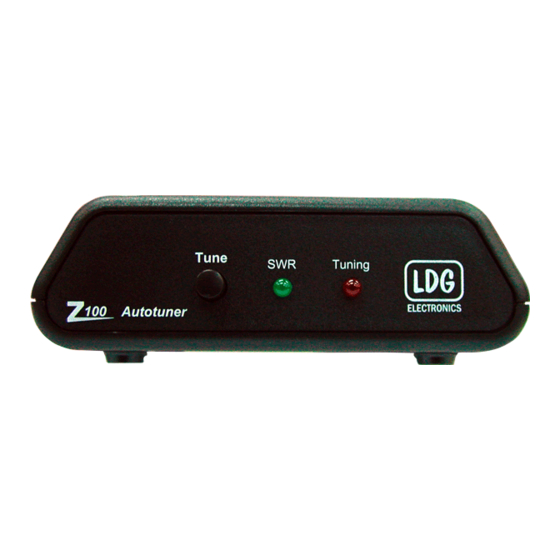
Summary of Contents for LDG Z-100
- Page 1 Z-100 Automatic Antenna Tuner Manual Version 1.1 LDG Electronics 1445 Parran Road, PO Box 48 St. Leonard MD 20685-2903 USA Phone: 410-586-2177 Fax: 410-586-8475 ldg@ldgelectronics.com www.ldgelectronics.com...
-
Page 2: Table Of Contents
LDG Z-100 Automatic Antenna Tuner Table of Contents Introduction Jumpstart, or “Real hams don’t read manuals!” Features Specifications Getting to know your Z-100 Installation An important word about power levels: Operating Instructions Basic operation: Function 1: Bypass mode (Short press) -
Page 3: Introduction
Jumpstart, or “Real hams don’t read manuals!” Ok, but at least read this one section before you transmit: 1. Connect your Z-100 to a source of 7 - 18 volts DC @ 300mA via the 2.5 by 5.5 mm power jack on the back (center positive). -
Page 4: Features
Your Z-100 is a quality, precision instrument that will give you many years of outstanding service; take a few minutes to get to know it. Your Z-100 can be used with any transceiver or transmitter with coax output operating in the HF range at no more than 125 watts output. - Page 5 The Z-100 has 200 memories, each of which stores the tuning settings for a specific frequency. When you tune near a previously tuned frequency, you can use “Memory Tune” to reset the tuner in only a fraction of a second. The process of storing tuning data in memory is completely automatic;...
-
Page 6: Installation
Installation Your Z-100 tuner is intended for indoor use only; it is not water resistant. If you use it outdoors (Field Day, for example) you must protect it from rain. The Z-100 is designed for use with coax- fed antennas. If you wish to use it with longwires or antennas fed with a balanced transmission line (e.g., ladder line), an external balun is required. -
Page 7: Operating Instructions
In this way, the Z-100 “learns”; the longer you use it, the more closely it adapts itself to your most often used bands and frequencies. You will probably use Memory Tuning most of the time; it takes... -
Page 8: Function 3: Full Tuning Cycle (Long Press)
LED will light and an automatic tuning cycle will begin. You will hear the relays in your Z-100 as they switch in and out seeking a match; they make a buzzing noise. The tuning cycle will end in a few seconds (red LED goes out); unkey your transmitter or transceiver and reset to your desired mode and power −... -
Page 9: Control And Status Indicator Summary
Z-100 is doing, and how it does it. In simple DC circuits, the wire resists the current flow, converting some of it into heat. The relationship between voltage, current and resistance is described by the elegant and well-known “Ohm’s Law”, named for Sir George Simon Ohm of England, who first described it in 1826. - Page 10 Simple tuners use variable capacitors and inductors. The operator adjusts them by hand while observing reflected power on the SWR meter until a minimum SWR is reached. Your LDG Z-100 automates this process.
-
Page 11: The Ldg Z-100
The capacitors are connected to ground with the seven inductor relays. Another relay switches the entire capacitor bank to the input or output side of the inductor. This switching allows the Z-100 to automatically handle loads that are greater than 50 ohms (high setting) and less than 50 ohms (low setting). -
Page 12: Care And Maintenance
Chokes are useful to remove RF interference from interface or DC power cables. Care and Maintenance Your Z-100 tuner is essentially maintenance-free; just be sure to observe the power limits discussed in this manual. The outer case may be cleaned as needed with a soft cloth slightly dampened in household cleaning solution.
















Need help?
Do you have a question about the Z-100 and is the answer not in the manual?
Questions and answers